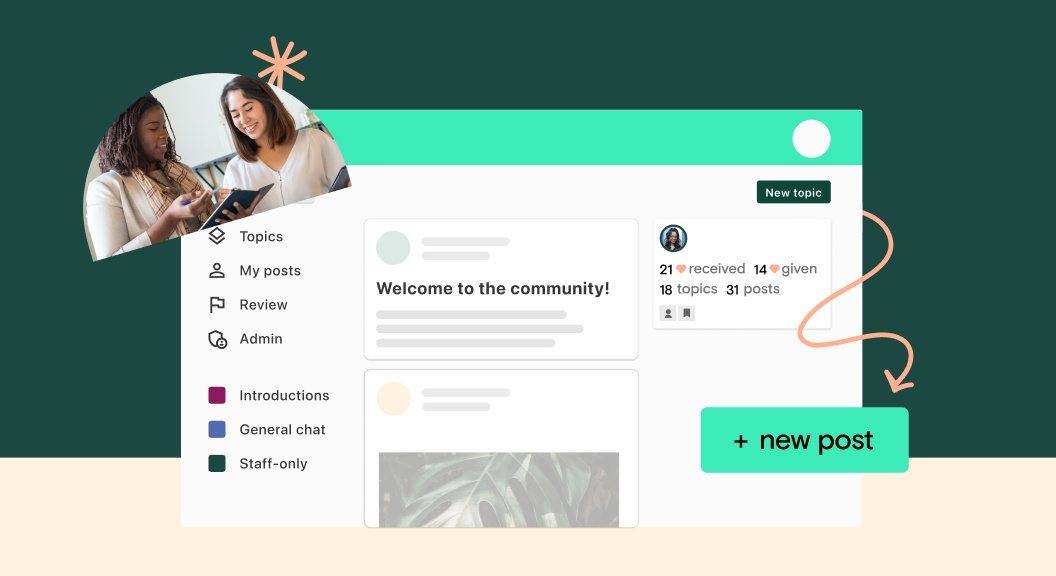Anyone launching a community does so with the hopes of creating a buzzing, lively space that’s invaluable to both their community members and their business. But, building genuine, ongoing online community engagement is no small feat. It’s something that takes time, strategy, and incredible buy-in and generosity from community members themselves.
If you’ve launched a community on Teachable recently or are ready to take the jump, congrats! We’re so excited you’ve taken that first step to foster connection with your students in a way that goes deeper than courses or coaching. But, if you’re not seeing the engagement that you were hoping for or you’re looking to revive a quiet space, we’re sharing some insights on how to approach building up online community engagement over time when that happens.
Community revival
When your community doesn’t get the engagement you were hoping for,, it can be easy to take that as evidence that you should scrap the whole project. It’s true that you should always validate a community project before launching (and doing so is a crucial part of forming a holistic community strategy). However, it’s also true that almost every community project starts off with less engagement than the community builder was hoping for. Building authentic relationships and establishing a steady flow of relevant content takes time.
Nobody’s paying attention to you, and that’s a good thing
The good news is that a community in need of engagement is oftentimes not as noticeable to your audience as you may think. While you may feel like you’ve been talking a lot and nobody’s been listening, oftentimes your community just hasn’t been paying very much attention.
When teaching your courses, you may have to teach information, review it, and give students a chance to practice their new knowledge. Similarly, when building engagement in a community, members won’t always respond right away. Repeating yourself several times isn’t a sign of failure. It’s an expected part of the process.
The upside to this is that you can continue to “start from scratch” at any time without being at much of a disadvantage. You haven’t lost your “one chance” to engage community members just because you’ve launched already.

Focus on small, first
Many community builders agree upon an ideal scenario: Growing your community slowly can be an effective way to form lasting relationships with members. And you should test and iterate on your community strategy with small groups before launching. Think about how much easier it is to have a genuine conversation at a dinner party than at a rave. And think about how much easier it is to go to a huge party with a small group of people you know than to make friends when you go to a party alone.
The reality of a community project in a business setting means you can’t do that. You may have practical reasons why you need to “open the floodgates” to your community. This could be granting access to every student who has paid for a certain course.
But what’s great about community building is that even if you’re working with a large community that’s become disengaged, you can still take a “slow growth approach”. And often, doing so is the key to creating genuine online community engagement akin to organic growth.
Even if you have a community of 1,000 or more members, you’ll get more impact from focusing on personal relationships. Focusing on 50 members versus creating massive community-wide engagements or automated sequences is actually more beneficial and scalable.

Slow burn, big payoff
Try things like forming a small sub-group to beta test a new community event series. Build a community advisory board to help you dial in on what community members really want. Or simply set up one-on-one calls between community members to help them form personal relationships. While those efforts might be hard to scale over time, as more community members form genuine bonds, they’ll help you to distribute the effort of bringing less engaged members into the fold.
Build connections the right way
Back to basics
Above all, remember that building a community, much like building a course, is not “if you build it, they will come.”
Communities are a product in and of themselves. They should be treated with the care and strategy of any other product. If you’re struggling with building online community engagement, you’re not alone. This is one of the core challenges that even professional community builders face in almost every new project.
Realizing that your engagement isn’t quite where you want it to be is simply a great opportunity to take a pause and revisit your community strategy. It’ll not only serve you now in building a more holistic plan for engagement that serves your business, but if and when you hit a roadblock down the road, you’ll be happy to have your strategy to lean on.
Noele Flower’s lean community launch framework is a great way to get started if this is your first community project and you’re not sure which elements you need to hit within a comprehensive community strategy.
Tags:










